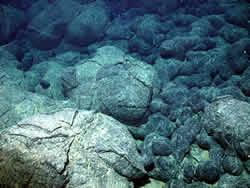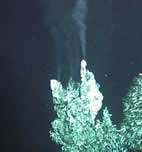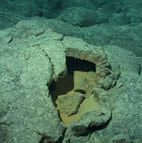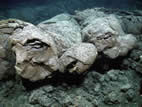
 |
| |
||||||||
|
|||||||||||||||||||||||||||||||||||||||||||||||||||||||||||||
 New lava which flowed around older lava pillows on Axial's caldera floor. (click image for larger view) |
As a geologist and teacher of Earth Science, I know and understand that plate tectonics is responsible for forming new ocean floor. Basaltic lavas are erupted along divergent plate boundaries at locations called mid-ridge ridges. These mid-ocean ridges collectively make up the longest mountain range on earth – almost all of it under water (Iceland is one exception – here the mid-ocean ridge appears above sealevel!). When my classes study plate tectonics many of the students don’t think of the ocean floor as being rock, but rather they believe it is all loose sediments similar to what they see at the beach. But the seafloor along mid-ocean ridges is so young it has not yet accumulated much sediment and is mostly bare rock. The other issue many students have is that they cannot imagine a long, more or less continuous line of volcanoes which is invisible to them being the source of the floor of the ocean basins.
This morning, from 4:00 A.M. to 8:00 A.M., I was working in the Jason control room on board the R/V Atlantis as it explored the northern portion of Axial caldera along the Juan de Fuca Ridge, an area where a divergent plate boundary combines with hotspot-type volcanism. Axial is 1580 meters below me and about 250 miles offshore from the coast of Oregon. As I watched the video display screens being fed by Jason’s cameras, I saw basalt lava flows that had erupted from on the sea floor below – relatively recent, bare fields of basalt not unlike what I might have seen where I grew up in southern Idaho on the Snake River Plain. The difference here is the presence of pillow structures that only form when basalts flow out under water. The occasional spider crab and fish also helped to remind me that I was definitely not out on land!
As I said earlier, students often have the perception that the ocean floor is loose sediment and there is no hard rock exposed! What I’m seeing on the screens shows what is more common to much of the mid-ocean ridge – hard rock with virtually no sediment on it. As Jason continues to move in a SE direction, it approaches a structure that is visible on the detailed maps of the sea floor that we use to guide us. This is the spot where the younger basalt flows in the caldera center meet older flows around the caldera’s perimeter. As Jason passes over the contact between younger and older flows, there is an immediate increase in the amount of sediment that coats the older basalts. It’s not enough sediment to hide the rock, but a light dusting that distinguishes the older flows from the younger ones. As the traverse continues away from the center of the caldera, we pass over another similar boundary that is visible on the maps – the rock past this contact is older still and has even more sediment covering it.
So give this some thought. Here at Axial, like other mid-ocean ridges, young, recent ocean floor basalts occur – this is where eruptions happen and the ocean crust is created. These rocks have no significant amounts of sediment on their surfaces. As you move away from the source onto older ocean floor, the amount of sediment on the surfaces increases. Think about a large ocean basin like the Pacific Ocean – where are the thickest accumulations of sediments going to occur, and where are you most likely to find bare rock? That’s right – the rock is visible at the spreading centers and the sediment thicknesses increase as you move toward the edges of the basins - up to over a mile thick in some places! For those of you along the Atlantic Coast, the youngest, rockiest sea floor is in the middle of the Atlantic Ocean and the oldest sea floor with very thick accumulations of sediment is near the coasts.
This whole story is not that big a deal, but seeing these changes in person makes it much more real, plus it’s a simple lesson I can take back to my land-locked students in North Carolina. I hope that being able to share my experiences and pictures will make it real for other teachers and students too.
|
Cruise Calendar
| ||||||
|
August 2007
| ||||||
| S | M | T | W | T | F | S |
| 1 | 2 | 3 | 4 | |||
| 5 | 6 | 7 | 9 | 10 | 11 | |
| 12 | 13 | 14 | 15 | 16 | 17 | 18 |
| 19 | 20 | |||||
Today's Events:
J2-288 ends at CASM and caldera floor geology survey.
AUV dive #2 at Axial.
|
Today's
photos |
|
click
caption for larger view |
 T&S Spires vent at the Casm site, Axial caldera. |
|
 Deflated pillow lava from Axial's caldera floor. Deflated pillow lava from Axial's caldera floor. |
 Exposed interior of a pillow lava. |
| NeMO Home |About NeMO | Expeditions | NeMO Net | Explore | Dive! | Education |